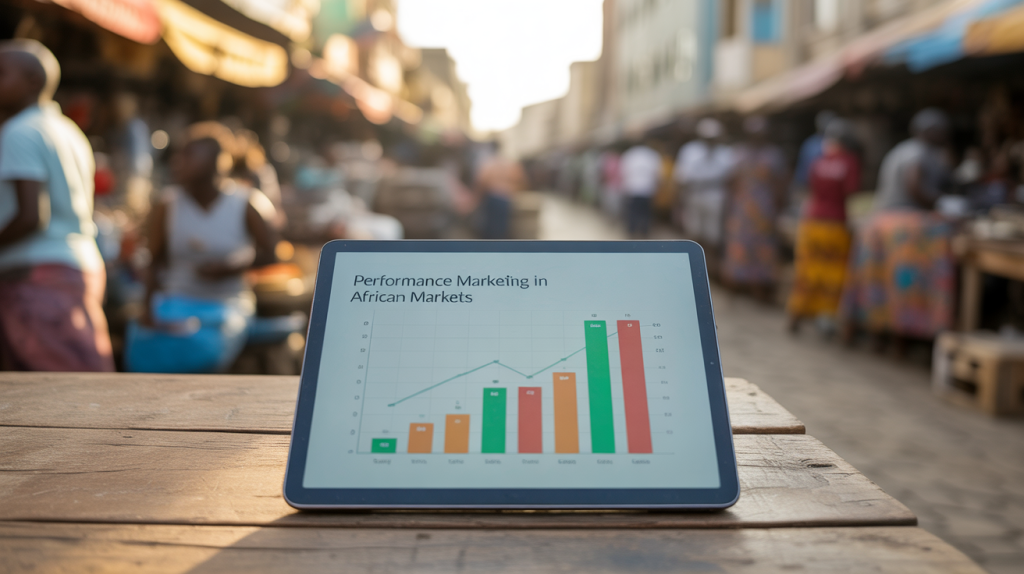Performance marketing in African markets is a whole different focus entirely.
And if you’ve tried running campaigns, this might sound familiar: your Customer Acquisition Cost (CAC) keeps climbing. Your ROAS looks fine on paper, but growth has flatlined. Meanwhile, your performance team burns budget, and your brand team talks about “awareness” without any clear attribution.
The uncomfortable truth is that it’s not that performance marketing doesn’t work here, it’s that without trust, it never had a chance.
Most global brands treat Africa like just another region: copy-paste your Facebook ads, tweak the targeting, expect conversions. But Nigerian consumers ignore your retargeting, and Kenyan B2B buyers don’t convert, despite the clicks.
The problem isn’t your targeting or your creative. It’s very likely that you’re trying to sell to people who’ve never heard of your brand, in markets where trust is currency and brand recognition drives decisions.
Why Performance Marketing Fails in African Markets: 3 Core Problems
Before we fix this issue, let’s talk about why your current approach is bleeding money.
Trust Deficit = Conversion Disaster
African consumers have been burned by international brands that over-promise and under-deliver. Your sleek landing page means nothing if they’ve never seen your CEO quoted in TechCabal or your product featured in Disrupt Africa.
Attribution Blindness
Your attribution models were built for markets where customer journeys happen mostly online.
In Lagos, Accra, and Nairobi, your target customer discovers you on LinkedIn, researches you via WhatsApp groups, and buys after seeing your billboard on Third Mainland Bridge. Good luck tracking that funnel.
Performance vs Brand Budget Wars
Your performance team wants more ad spend. Your brand team wants PR and events. Nobody can prove which drives revenue because nobody’s tracking the full picture. So you keep doing both badly instead of one thing brilliantly.
The solution isn’t choosing between brand and performance. It’s integrating them so tightly that trust and conversion become one engine.
How to Fix Performance Marketing in African Markets: 6 Integration Tactics That Work
To succeed with performance marketing in African markets, you need more than good creatives, you need integration. These six tactical shifts combine brand building, local trust signals, and strategic targeting to help you break through resistance, build credibility, and turn ad spend into meaningful, measurable growth across diverse African consumer landscapes.

1. Use PR Credibility to Cut Your CAC in Half
Here’s what we’ve learned working with fintech and SaaS brands expanding into Africa: PR coverage cuts customer acquisition costs faster than any targeting optimization.
When your CEO gets quoted in Techpoint Africa about fintech regulation, that’s not just “brand awareness.” That’s social proof that makes your retargeting ads work 3-times better.
Here’s how to do it:
Track PR mentions and syndicate them through your paid social immediately. Turn every press hit into ad copy. Use journalist quotes as testimonials in your landing pages.
Here’s what we see consistently: When executives get quoted in respected African tech publications like Techpoint or TechCabal, their paid social performance improves dramatically. The social proof from earned media makes retargeting campaigns significantly more effective.
2. Turn Thought Leadership Into Performance Gold
Anonymous ads are losing their power. But expertise-driven content built through personal/expert-led marketing still builds trust.
Your performance campaigns should amplify content where your executives actually teach something valuable. Not generic “5 Tips for Better X” content, but contrarian takes that only someone with real experience would know.
Integration that Work:
Every piece of thought leadership content gets a paid distribution strategy from day one. LinkedIn native ads to decision-makers. Twitter promoted posts to industry conversations. Retargeting to everyone who engaged.
The most effective B2B campaigns we’ve seen in African markets start with genuine expertise. When a CEO writes contrarian insights about real industry challenges like supply chain bottlenecks, regulatory hurdles, infrastructure gaps, and backs it with strategic paid distribution, the engagement quality is exceptional. It’s not about viral content; it’s about reaching the right 500 decision-makers who actually have these problems.
3. Build Custom Audiences from PR Coverage
Your PR team generates media coverage. Your performance team burns budget on cold audiences.
Can you see the disconnection?
Every press mention, podcast appearance, and industry event creates an audience of people who now know you exist. These are your warmest possible targeting segments.
Here’s how to do it:
You would create custom audiences from everyone who visited your site after each PR hit. Also retarget people who engage with your shared press coverage on social media. Build lookalike audiences from PR-driven traffic.
Smart brands track traffic spikes after major press coverage and immediately build custom audiences from that engaged traffic. These are people who’ve already shown interest through earned media – they’re exponentially warmer than cold targeting. The retargeting campaigns to PR-driven audiences consistently outperform standard demographic targeting.
Read Also: Key Marketing Metrics Every Business Should Track
4. Crisis Communication + Performance Recovery
When things go wrong (and they will), most brands treat crisis management and business continuity as separate problems. Your PR team handles the messaging while your performance team watches conversion rates crater.
Smart brands coordinate both responses simultaneously.
The integration move:
Your crisis communication strategy includes immediate paid media adjustments. Redirect ad spend from growth campaigns to trust-rebuilding content. Use retargeting to deliver transparent updates to existing customers before they churn.
When a payment processor faced security concerns, we helped them turn crisis PR into trust-building campaigns that actually improved customer retention. Transparency became their competitive advantage.
Read Also: Social Marketing For B2B Companies: Effective Strategies and Best Practices
5. Influencer Amplification with Conversion Tracking
Everyone’s doing influencer marketing wrong in African markets. They pay for posts, get engagement, and most of the time, have zero idea if it drives business.
The fix isn’t better influencers. It’s better integration between influence and conversion.
The integration move:
Every influencer campaign gets a corresponding paid social strategy. Use their content as ad creative. Retarget their audience with conversion campaigns. Track the full funnel from influence to purchase.
Most brands waste influencer budgets by treating posts as one-off content. The strategic move is using influencer content as the foundation for paid campaigns. Their authentic product demonstrations become your ad creative. Their audiences become your custom targeting segments. It transforms influencer marketing from vanity metrics to conversion engines.
6. Account-Based Performance Marketing in African B2B Markets
African B2B markets are tight-knit. For instance, in Lagos, the senior executives at major banks all know each other. In Johannesburg, mining company CEOs move in the same circles. When you’re targeting enterprise accounts in these markets, you’re not just reaching individual decision-makers – you’re entering interconnected professional networks.
This creates both opportunity and risk. Get it right with one influential prospect, and word spreads through their network. Get it wrong, and the damage travels just as fast.
The solution is to layer your Account-Based Marketing (ABM) with credible media presence. Your LinkedIn ads hit harder when prospects have already seen your CEO quoted in BusinessDay. Your sales calls get better responses when your target accounts recognize your brand from TechCentral or IT News Africa.
Here’s what works:
Time your PR and paid campaigns together. While your PR team pitches your latest funding round to TechCabal, run targeted LinkedIn ads to the same companies you’re trying to reach. When your head of product gets featured in a Disrupt Africa interview about industry trends, amplify that content directly to your target accounts.
African enterprise buyers want to work with companies that other industry leaders respect. They check who else is using your solution and whether you’re mentioned in the publications they read. Your ABM strategy needs to account for this reality.
The enterprise sales teams seeing the best results coordinate their media strategy with their account targeting from day one. They know that in markets where reputation travels fast, you need both earned credibility and targeted reach to win deals.
In markets where reputation travels fast, media and ABM must work together. If your strategy doesn’t build trust before the first sales call, your competitor’s will.
Why This Actually Works (And Why Most Brands Never Try It)
The reason integrated PR and performance marketing drives better ROI isn’t magic. It’s psychology.
African consumers make purchase decisions based on trust, social proof, and community validation. Your performance campaigns provide the targeting and tracking. Your PR efforts provide the credibility that makes people actually convert.
But here’s why most brands never implement this: it requires your teams to actually talk to each other.
Your PR agency needs to share their editorial calendar with your performance team. Your performance team needs to share attribution data with your PR team. Your brand budgets and performance budgets need to work toward the same goals.
Most organizations would rather keep teams in silos than deal with the coordination required. Their loss. Your opportunity.
The Bottom Line: Integration Isn’t Optional Anymore
If you’re expanding into African markets and still treating PR and performance as separate functions, you’re literally throwing money away.
The brands winning in Lagos, Nairobi, and Accra aren’t the ones with the biggest ad budgets. They’re the ones where trust-building and conversion optimization work as one machine.
Your competitors are still fighting budget battles between brand and performance teams. While they’re arguing about attribution models, you could be building an integrated engine that drives both credibility and revenue.
Ready to stop wasting money on fragmented marketing? Book a strategy session with WhirlSpot and see how integrated campaigns actually work in African markets.







This Post Has 2 Comments
Pingback: African PR Strategy Guide: 5 Critical Mistakes Global Brands Make When Expanding to Africa - WhirlSpot Media | Integrated Digital Marketing and PR Agency in Nigeria
Pingback: 5 Questions Smart Brands Ask Before Their African Market Entry Strategy - WhirlSpot Media | Integrated Digital Marketing and PR Agency in Nigeria